Kids Web Japan
Web Japan > Kids Web Japan > Meet the Kids > Chado > Events at Mushakouji Senke
Meet the Kids
Chado or Sado
(Tea Ceremony)
Events at Mushakouji Senke
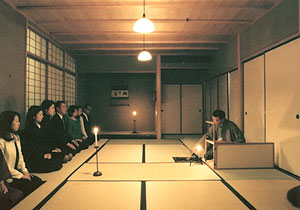
Robiraki, an event that is considered the "New Year of tea."
Robiraki
Kids Web Japan visited the Mushakouji Senke's Tokyo center on November 22, 2002. The event taking place on this day was the Robiraki (also called Kuchikiri no Chaji), in which participants enjoy the new tea of the year prepared with the ro. This is the day when the ro is reopened for the first time in months, and it will be in use from this time up through April.
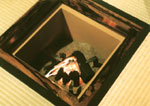
Charcoal pieces are stacked up in the ro.
Heated charcoal crackles in the ro, suggesting the coming of winter. Celebrating the opening of the ro, the guests are treated with zenzai, sweet bean soup with rice cakes inside; rice cakes are typically served during the New Year and on other special occasions. The zenzai is followed by koicha.
"The Kuchikiri, in which we drink that year's new tea for the first time, is also known as the New Year in the tea calendar. In order to go back to basics, today I've chosen the most standard utensils," explains So'oku.
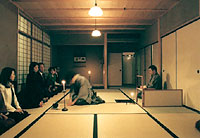
Entertaining the guests with fresh tea.
The kama (pot) used this day is said to have been owned by none other than Rikyu 400 years ago. Moreover, the kuroraku bowl used this day to serve tea was produced in the first half of the seventeenth century. It is said to be one of the most representative works made for chado.
Hatsugama
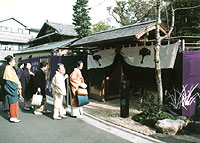
Women in their best dress flock to the center in Tokyo.
The tea ceremony held at the beginning of the year is called the Hatsugama. On the morning of January 18, 2003, the Tokyo center has been beautifully decorated with hangings for the New Year. A large number of guests, including many women in kimonos, arrive one after another and fill the place with a festive air. On this day, six sessions of 30 guests each are to be held, so that a total of about 200 guests will be entertained with tea.
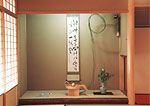
The alcove is decorated to celebrate the New Year.
At around 11:30 a.m., the first session begins. The large hall on the second floor is adorned with red and white camellia flowers and wanryu (willow branches knotted together, which symbolizes the tying and connecting of the year that has just passed and the year that has just started). The fourteenth-generation tea master Futessai Soshu prepares koicha while explaining to the guests about the utensils that have been selected for the day.
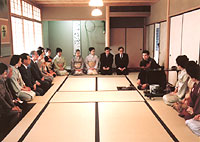
The Hatsugama ceremony.
While koicha is being served in the large hall, So'oku prepares usucha and entertains many visitors in another room. He tells Kids Web Japan, "Sometimes we use the same flowers and same scroll for several years in a row. This has the significance of allowing guests to feel the coming of the New Year by seeing the same, unchanged tools."
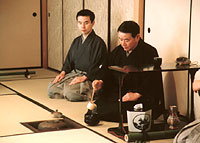
So'oku, left, with his father Soshu.
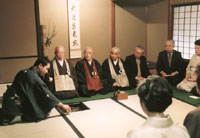
So'oku played host by serving usucha to guests.